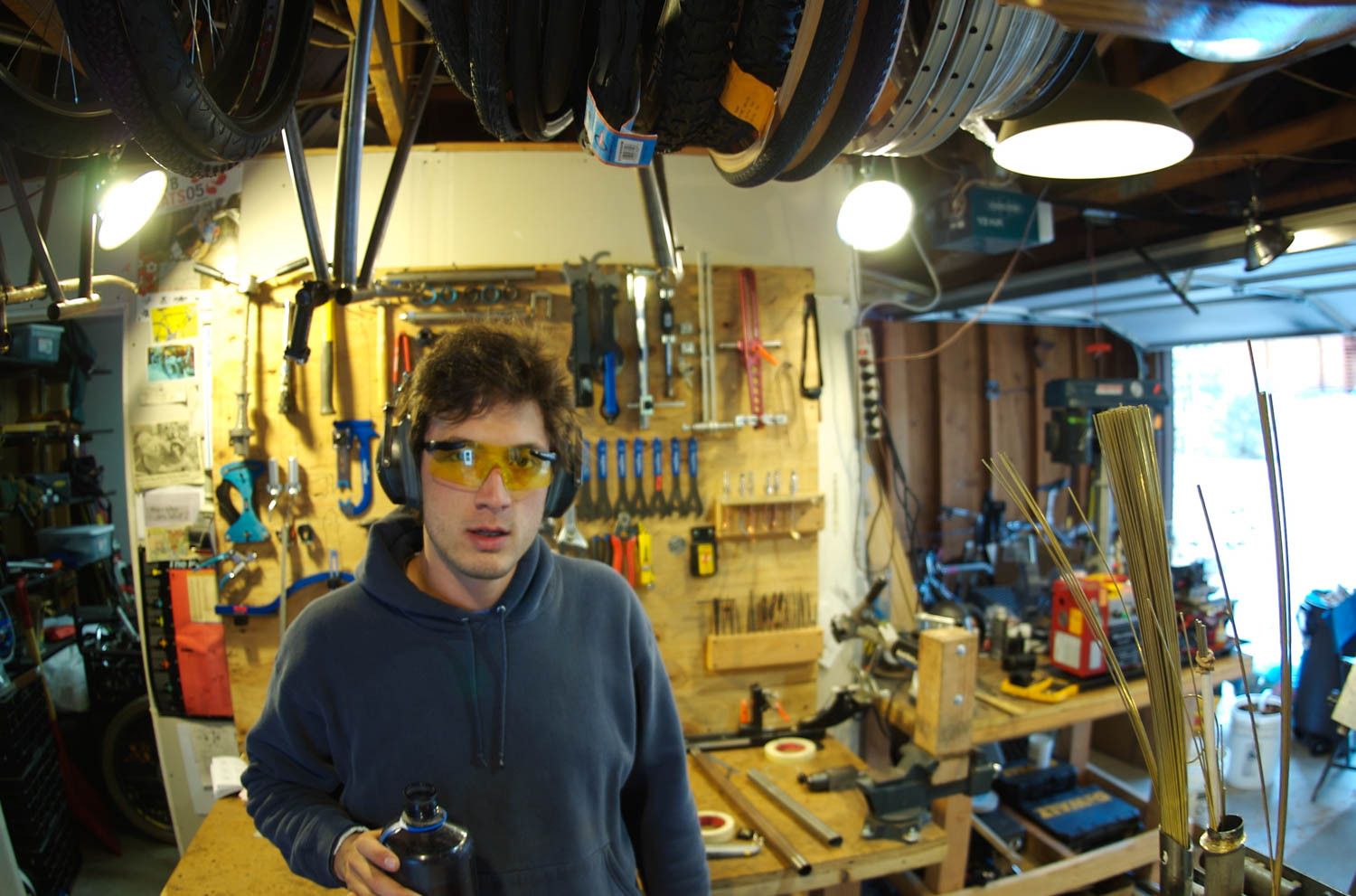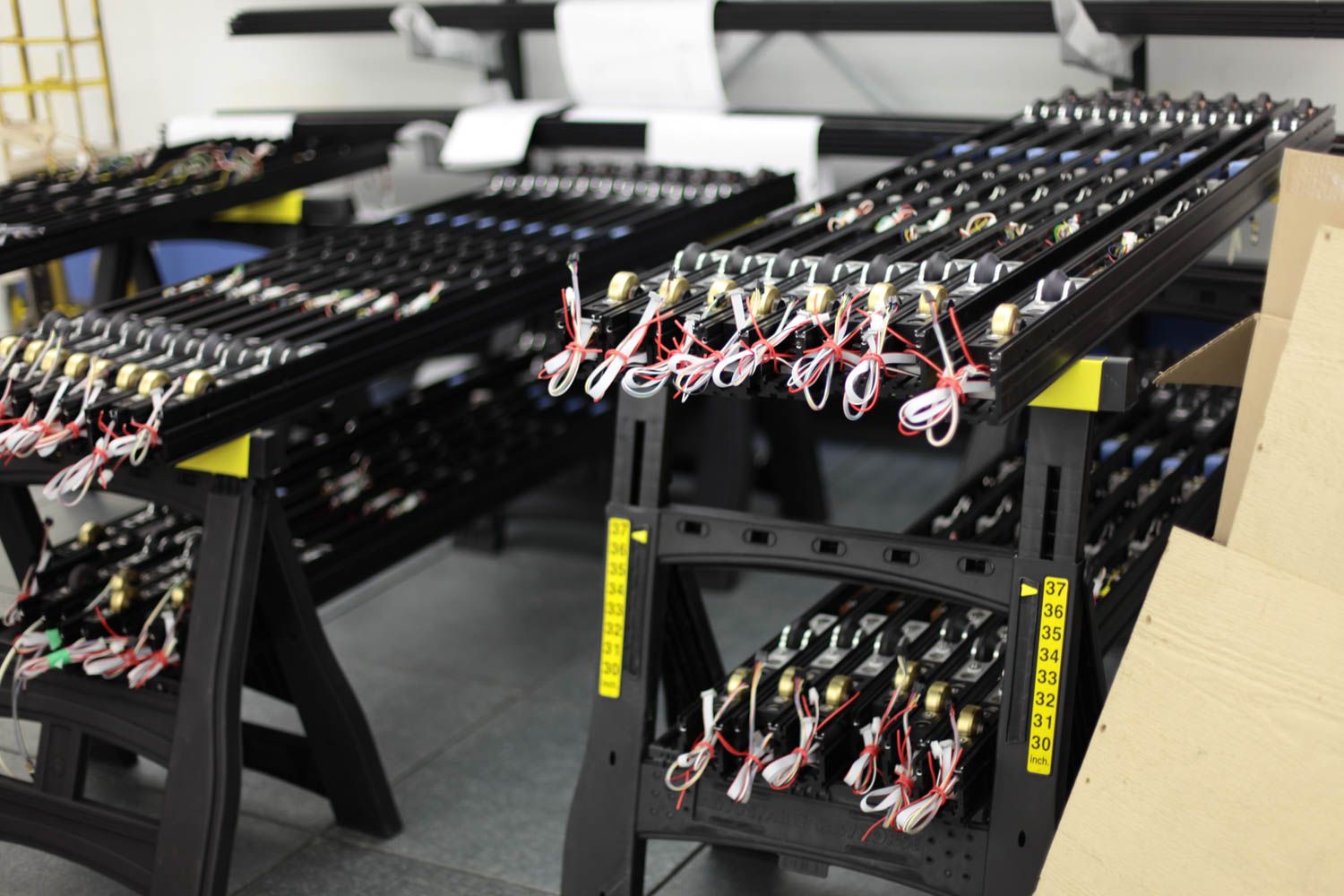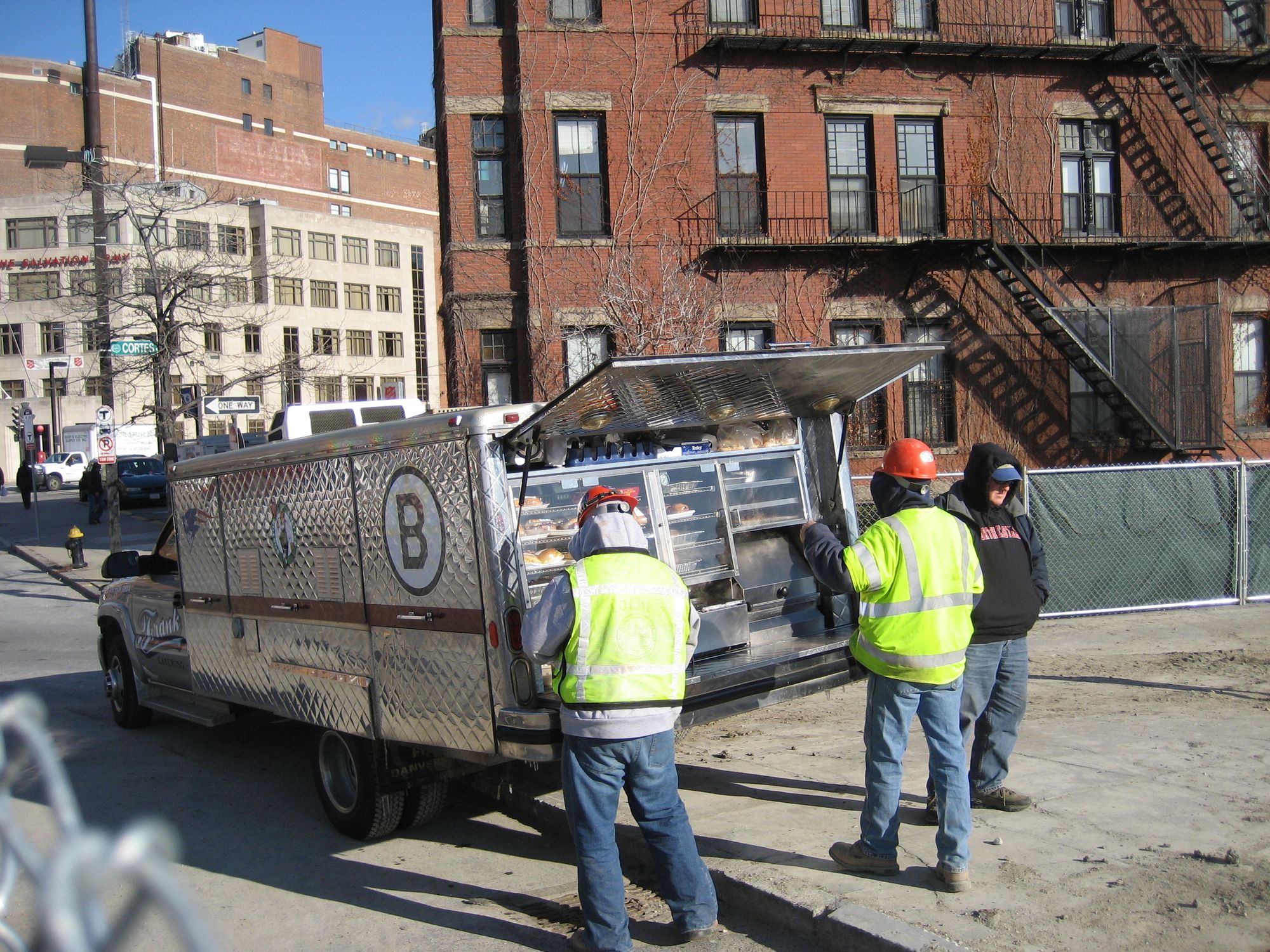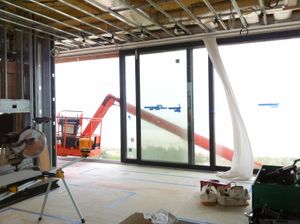On countless occasions since I stopped working in the construction industry, I have explained my childhood and early career by saying, with more or less no context, that “I grew up on jobsites.” It is something that I’m fond of saying, mostly because of the hardworking credibility that it implies. The credibility may, or may not, be fully earned. But the phrase “I grew up on jobsites” is just so succinct, and most of the ways in which it could be interpreted are at least vaguely true, and anyway we’re talking about things that happened two decades ago now and how much detail could possibly be justified?
Whether in spite of or because of its indeterminacy, I believe that the description manages to convey something about the warm feelings I have for jobsites. One thing I love about them is the way in which they lack architectural programming. A workshop is highly programmed: each tool is kept in a particular place, and each area of the workshop is organized for a particular kind of work. But in the field, things are more fluid. There’s typically some kind of staging area, where shipments are received and materials are organized, and the jobsite supervisor will often keep a makeshift office somewhere on site. But for the average carpenter or tradesperson, your environment – the area where you’re working, and the way it is laid out – is in more or less constant flux.
“More or less constant flux” isn’t a description that I find myself naturally drawn to, and yet my memories of working in the field are fond. In the workshop and elsewhere, I can get prickly about organization, cleanliness, and order. But there is something about the chaos of a jobsite that I find relaxing. Where a workshop is a walled garden, a jobsite is like a jungle: we can’t really hope to understand, let alone manage, its complexity.
-Spencer Wright
The most clicked link from last week's issue (~8% of opens) was a Hacker News thread about Sam Zeloof and Jim Keller's new semiconductor fab. In the Members' Slack, excellent sourcing advice is paired with a healthy dose of bizarre direct-to-consumer offerings. Does anyone need an airplane escape slide?
JOBS.
- Glowforge is hiring a hardware reliability engineer in Seattle.
- Unspun is hiring a textile engineer in SF.
- Rewiring America is hiring a remote electric curriculum designer.
- Terraline is hiring a staff mechanical engineer in Fremont, CA.
- Impossible Foods is hiring a senior R&D technician in Redwood City, CA.
- More jobs on Scope of Work's job board; you can promote the role you're hiring for here.
SPONSORED (ish).
If you live in NYC and find yourself nodding along with anything in this newsletter, you should *really* check out the New York Industrial Collective. Located in the heart of Brooklyn, NYIC offers both flexible and full-time access to woodworking, prototyping, electronics, and metalwork facilities – in a space that’s *way* nicer to work in than your kitchen.
PLANNING & STRATEGY.
When I was roughly college-aged, my father described someone who I knew as a carpenter as “an excellent mechanic.” At the time I thought of a mechanic as someone who worked on cars, though I suppose if I had considered it for a while I might have included other heavy machinery. But I think my dad meant that this person understood mechanisms in a broad sense (the cylinder of a lock, the steering geometry of a bicycle, an obscure piece of business software) and could explain, predict, and alter how they worked. It was clearly a high compliment, as if this person had attained some sense of wisdom. To be an excellent mechanic was to understand the world in ways that other people did not, and time spent in a workshop was spent in pursuit of that understanding.
My mental model of workshops has evolved over time. During college, I grew to understand them as distinctly social spaces – somewhere that you might establish and develop friendships. Still later I came to appreciate my own workshop as a fortress of solitude – somewhere where I could hole up for months, eventually emerging to unveil some impressive achievement.
Since 2018 I’ve worked out of what is now known as the New York Industrial Collective, a shop that I rented out ostensibly for the purposes of running this newsletter and which eventually developed its own identity. For the first couple years I was there mostly during the workday, but for much of 2020 my shop time was limited to late nights, when I would ride my bike there and just putz around alone for hours. To calm my fried nerves I invented projects for myself, the most notable of which was the WWII-era drill press that I repainted (way too much work) and made a bunch of upgrades to. The project challenged both my abilities and my tolerance for suffering, but in the end it was a salve. I wasn’t pursuing wisdom in the workshop, and the project wasn’t a social experience, and the finished product wasn’t especially meaningful to me. But the workshop had evolved into a place that calmed me, and that was enough.
MAKING & MANUFACTURING.
Perhaps the most important jobsite skill is the ability to perform high quality work in a place that lacks ergonomic affordances. Jobsites are uncomfortable: you might be on a ladder all day, or clearing rubble out of an old crawl space, or kneeling on a cold, hard surface. In January of 2004, I spent about a month on a jobsite on the west side of Shelter Island, NY. The project was a major renovation; an old house had been lifted off of its foundation and placed on temporary cribbing, and part of my job was to stoop around underneath it, measuring its footprint accurately so that a new foundation could be poured to the correct dimensions. The wind, which was obstinate, came directly off of the bay to our west, and as I recall it the wind chill brought the temperature to around -20° C. I wore basically every warm piece of clothing I owned, but the work was fiddly, and for much of the day my fingers were bare and very cold. In an act that I saw as deeply kind, the jobsite supervisor gave us an extra 15-minute break one day so that we could huddle inside around a propane-burning heater. I think he also brought us paper cups of hot coffee, which I had only recently started drinking. We were all terribly cold, and this one little heater was the closest thing we had to comfort, so we stood around it and commiserated.
I remember this all fondly; the suffering I’ve endured on jobsites is a badge I wear with honor. And yet as I moved away from jobsites and into workshops, I’ve structured my workshop such that it minimizes discomfort more or less at all costs.

In The Anarchist’s Workbench, Christopher Schwarz (a woodworker, writer, and self-described “American aesthetic anarchist”) presents a taxonomy of Western woodworking workbenches. “Different workbench forms are broadly allied with different woodworking trades,” he writes. “So as you choose the form of workbench you want to build or buy, consider the tradition your work falls into.”
The tradition I come from is residential stick-framed construction, but these days most of what I do in the workshop involves my bikes. My main workbench, which is directly across from the bike stand, has a butcher block surface and a t-slotted aluminum extrusion base. It looks great and is well suited to my practice of maintaining multiple bike projects at once, but the truth is that I want to spend more time at a big mechanic’s workbench, right in the middle of the workshop – a place where I can stretch out a bit, and switch off whatever tradition or modality I’ve been spending my time in.
On a jobsite, these kinds of spaces emerge naturally. In the winter they’re near the heater, and in the summer they’re probably in the shade, and either way they offer a bit of comfort in an otherwise hostile environment. But in a workshop, there’s a tendency to design every little corner so that it can be used comfortably and efficiently – leaving nowhere to have coffee but at your individual workstation. Avoid this. While a large, heavy, workbench that isn’t tied to any particular task might seem like a waste of floor space, it provides many things that a process-optimized workstation never will.
MAINTENANCE, REPAIR & OPERATIONS.
My first jobsite experience was as a sixteen-year-old on spring break. I had no skills to speak of. Before dropping me off at work, my father had taken me to the lumber yard and purchased me a tool belt, a hammer, and a tape measure, each of which I understood how to use but was anything but confident with. I vaguely recall doing some light demolition that week, but my primary responsibility was to sweep the floor and take out the garbage – two activities that I still derive a significant amount of satisfaction from.
My current workshop, though, has been particularly tricky to keep clean. Our floor surfaces are painted wood, laid diagonally in 3” wide stock. (Editor’s note: Both Scope of Work and The New York Industrial Collective operate in metric units. But some accommodations must be made when describing things which were designed and built in feet and inches.) Nearly every board is surrounded by quarter-inch gaps, which collect dust and debris constantly. They’re difficult and time consuming to vacuum, and sweeping tends to leave wads of sawdust everywhere. Recently I tried using a sweeping compound, itself a dust-like substance which is sprinkled over the floor and then (as a Youtuber named “Dirty John” shows here) swept up and disposed of. Made of an aggregate (often sawdust) and some kind of coagulant (typically oil or wax), sweeping compound sticks to whatever you’re trying to sweep up, keeping dust from being thrown into the air and helping to clean the floor surface. The stuff seems to work; it also gets trapped between our floorboards; my search continues.
DISTRIBUTION & LOGISTICS.
I have an issue with kaizen foam, which is that there’s nothing kaizen about it.
The idea of kaizen, which is largely associated with the Toyota Production System but was apparently developed in the US during WWII, entails a process of continuous positive change. “Don’t rebuild your process in an attempt to make it perfect,” the advocate of kaizen would say. “Instead, just try to make it a little better, all the time.” Kaizen encourages you to keep your workshop flexible and adaptable – using, for instance, lightweight workbenches that are easy to rearrange.
Kaizen foam, on the other hand, is excruciatingly difficult to make incremental improvements to. Made of laminated layers of closed-cell polyethylene, kaizen foam is installed into tool chests and used to organize tools. Tools are meticulously laid out (“knolled,” you might say) on top of the foam and traced with a marker; the outlines are then cut, leaving negative images of each tool. Every wrench and screwdriver then has a perfect nest to sit in – until you replace or upgrade something, and it doesn’t fit in the old tool’s nest, and you have to throw out the whole sheet of foam and start again.
Kaizen foam is antithetical to the practice of kaizen, but it does align with another Japanese management technique: 5S, which outlines five steps that can be used to ensure that a workspace is capable of efficient and effective work. 5S encourages consistent, and consistently high, standards. In some ways, 5S and kaizen represent competing tensions in the workshop: In an effort to optimize your workspace, you might build out increasingly specialized workstations and storage areas. But to allow for continuous improvement, some degree of flexibility needs to be maintained.
INSPECTION, TESTING & ANALYSIS.
Working in a shared shop can be hard. My own standards for cleanliness and organization are, as shown by the roughly two thousand words that appear above, highly personal and idiosyncratic. And yet I struggle with the idea that anyone – even a mechanic whose work I deeply respect – might operate their workshop by different standards.

Over the past few years, the person most associated with a strict set of workshop standards is probably the artist Tom Sachs. Sachs’ standards became the topic of much discussion after it became evident to people outside the Lower East Side art world that his personal assistant might have the most humiliating job in New York City; I am not part of that world, but I’m assured by people who are that Sachs’ studio has long been known as a hostile and cultish place to work. Sachs’ artwork is often explicitly about rules, which are presented in a way that is both clever and capricious. The most famous of these is probably “always be knolling,” which strikes me as rather silly, but the motto of Sachs’ that bothers me more is “it won’t fail because of me” – which he has gone so far as to print on childrens’ t-shirts. The quote apparently originated from Ken Mattingly, an Apollo astronaut who described visiting the Saturn V late at night when it was under construction. Arriving at the launch pad, he came across a rather startled technician who was working in the instrument unit. Mattingly expressed curiosity about what he was working on (Mattingly: “We’d spent years learning about the spacecraft and didn’t know anything about the rocket”), and the technician eagerly showed him around. The technician expressed a sense of awe at the mission, and seemed almost doubtful that the astronauts could get back from the moon, but added that “you can bet it won’t fail because of me.”
It’s an inspirational story, and there’s part of me that wants to apply it to my own comparatively mundane work – as Sachs has. When we’re in the workshop, perhaps we should hold ourselves to the same standard as that technician. Nobody should slip and fall, because we have swept the floors; no tool should be misplaced, because we’ve organized them all perfectly; nobody should get locked into one modality, because we’ve made sure to establish a big, general-purpose mechanic’s bench in the middle of the shop.
Then again, maybe I should enter the workshop with something on my mind other than failure prevention – whether it’s the pursuit of wisdom, or the pleasure of working with other people, or just the calm that comes from a few hours of putzing around.
SCOPE CREEP.

On the jobsites I worked on as a younger person, a lunch truck would pull up twice a day to sell coffee, snacks, and food. On well-run jobsites they would be punctual, and would blow their horn as they arrived – marking the moment at which our coffee and lunch breaks officially began. They might be referred to as “lunch trucks,” but my preferred term was “roach coach.” On the back there would typically be a spigot, out of which came black coffee; I liked to think of the coffee tank being nestled up against the gas tank, though I suppose near the radiator would make more sense.
Anyway, sometime during the last year or so that I spent on jobsites – this would be 2011 or 2012 – I became fond of making “roach coach mochas,” which consisted of a pack of powdered hot chocolate and a glug of coffee, topped off with half-and-half. If that were all that I could drink on cold mornings for the rest of my life, I wouldn’t complain.
Thanks as always to Scope of Work’s Members for making this newsletter possible. Thanks also to Phil Alford, Paul Pianpiano, Tom Stewart, Craig Blevins, and my father – all of whom played a huge role in helping me find self-confidence through working on a jobsite.
Love, Spencer
p.s. - I’m looking for workshop inspiration for a few projects we have going on at Scope of Work. Reply to this email and send us photos of your workshop, your workbenches, and your tools – and maybe something fun will come of it ;)
p.p.s. - We care about inclusivity. Here’s what we’re doing about it.



